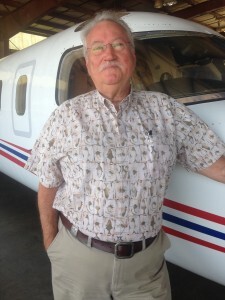First published in Flight Levels Online, Winter 2014 issue
April 1, 1977 was a great day for Gary Riggs. After 14 years working on the production line at the Rockwell Commander factory in Bethany, Oklahoma, and then as a mechanic at the factory-owned service center in Dallas, he now had a shop he could call his own. Riggs had backing from a couple of brothers who operated a 680V Commander, but it was Riggs’s shop to operate, manage, and grow. Riggs brought four other experienced Commander technicians in on the startup, and on April 1, 1977, they opened the doors to Mid-Continent Airmotive at Clarence E. Page Airport in Yukon, Oklahoma, west of Bethany. A great day, indeed. Then, before day two dawned, it all came crashing down –– literally.

“I had hired two night watchmen to guard the place, and one of them was pretty gullible,” Riggs remembers. “I told him that someone –– probably Downtown Airpark –– might try to blow the building up. Well, in the middle of the night I got a call from them saying that a bomb had been set off in the hangar. I jumped in my car and raced to the airport. But as I turned off Highway 66 I thought, ‘It’s April Fool’s Day –– they got me!’ Then I turned the corner into the airport, and I could see that the roof had caved in.”
Turned out it wasn’t a bomb that brought down the roof but a Ford Torino. “A guy on drugs drove onto the airport, crossed the runway and ramp, and drove right into the northwest corner of the hangar,” Riggs explains. The car center punched the corner I-beam supporting the roof, which collapsed. The top of the car was sheared off, but the driver wasn’t hurt. After just one day Riggs was out of business until the building could be repaired and the roof replaced. “That was our start,” he chuckles.
Fortunately, things improved. Riggs and his team –– chief inspector John Gosney; parts manager Donnie King; electrical and environmental systems specialist Robert Smith; and mechanic Tom Pickle –– did whatever it took to build the business. Many a time we worked all night long, went home to take a shower, and then went back to the airport,” he says. “We worked it that way for a long time, sometimes using some part-time help to stay on schedule.”
Riggs focused the business on performing scheduled inspections. “We were a small shop. We didn’t get in the modification business,” he says. Over the years Mid-Continent has had its hands on every Commander model built except for two –– the 720 Alti-Cruiser, and the 700. They’ve found snakeskins, spiders and exotic bugs and critters in the nooks and crannies of airframes, but never any drugs. “We discovered drug agency tracking devices in some tailcones, but we just looked the other way,” Riggs says.
Having an experienced technician working on your Commander is especially important because, as Riggs explains, each one was hand built and thus no two are exactly the same in every detail. “That’s what makes them so unique,” Riggs says.
After five or six years wrenching on airplanes at Mid-Continent, Riggs found he had to devote all his time to running the business. One thing he hasn’t had to worry about is his crew, some of whom have been with him for more than three decades. “It’s been a dependable family,” he says.
Riggs decided in June 2012 that it was time to retire, or so he thought. “It didn’t work out,” he says. “But my wife took me at my word and she did retire from teaching. She gave me an F in retirement.”
Now, after more than 37 years at Mid-Continent, Riggs say “I’m done.” Legacy Aviation Services, Riggs’s neighbor at Clarence E. Page, has acquired Mid-Continent. Riggs is serving as an advisor to Legacy, but he’s already enjoying his new life. “I’ve been doing grandpa stuff all week,” Riggs responds when asked how he will spend his days. “I’m having some good times.”
A lifelong motorcyclist who owns two Harley-Davisons, Riggs and his wife plan to take some road trips. He also will continue to take his KTM 400E to Colorado, Arizona, and other states that offer great off-road riding.
In the 1960s Riggs worked as a mechanic at a flight school and took his $5-an-hour pay in instructional time. He soloed, but realized he much preferred working on airplanes to flying them. The brief exposure to flying did give him a pilot’s perspective, which helps sharpen his highly experienced mechanic’s eye when sizing up airplanes. That eye gazes fondly on Commanders. “I just love those airplanes,” he says. “They are real pilots’ airplanes. And tremendously attractive. Just beautiful with that high wing.
“I think the world of Commanders,” he says. “They have fed my family for a long, long time.”
